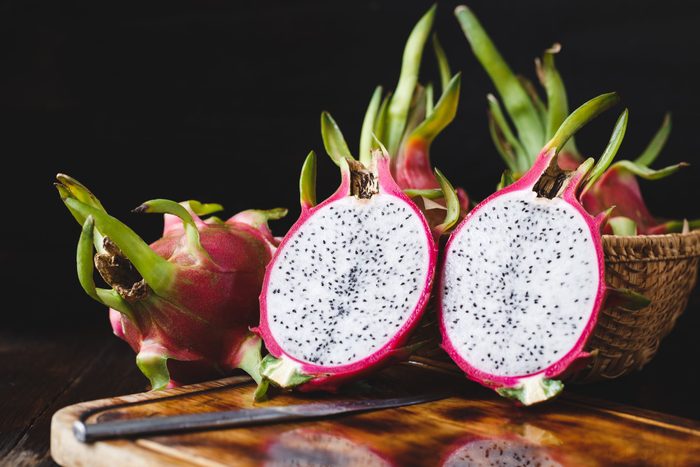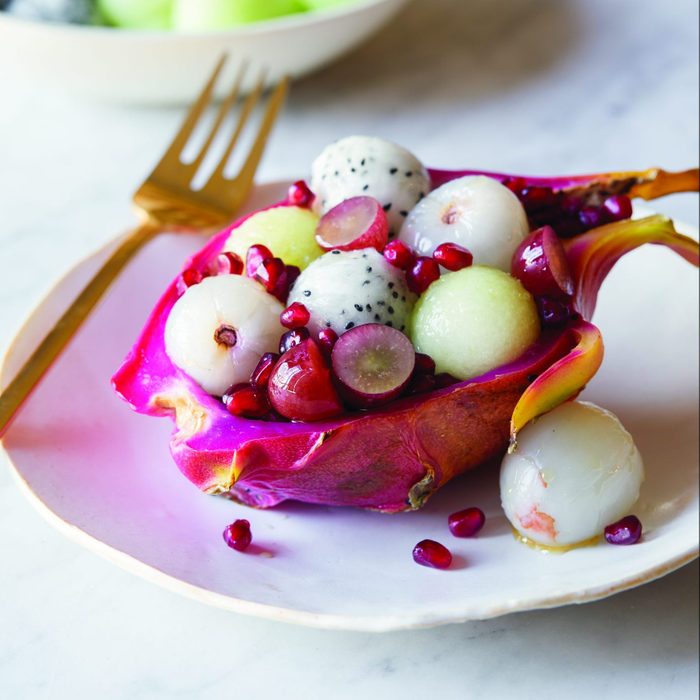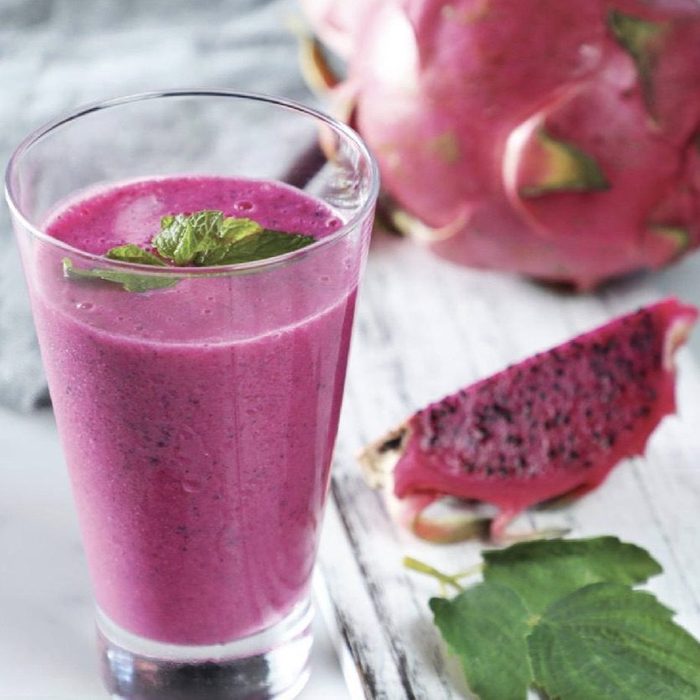6 Reasons Nutrition Experts Love Dragon Fruit

Dragon fruit—aka pitaya—is packed with healthy nutrients. Learn exactly what this exotic fruit is, how to prepare it, and check out some tasty recipes.
We all know it—we’re supposed to get somewhere between two to five servings of fruit and vegetables per day. Maybe you’re falling short. Or maybe you’ve fallen into a fruit rut, constantly reaching for the same healthy-but-boring option—hello, bananas. Enter dragon fruit, a lesser-known but increasingly popular choice.
Also known as pitaya, dragon fruit gets its name from its spiky exterior, says Akua Woolbright, MD, national nutrition director for Whole Cities Foundation, the nonprofit arm of Whole Foods. It’s not just a funny-looking food—dragon fruit reportedly has a whole host of nutritional benefits. Nutrition gurus praise its ability to boost antioxidants, support gut health, and even help manage diabetes.
We spoke with nutritionists and food experts to find out everything there is to know about dragon fruit, including where it comes from, how to enjoy it, and whether its benefits really hold up.
(Related: How Much Do You Know About Antioxidants?)
Origins of dragon fruit
These days, you’ll find dragon fruit in your local grocer’s produce section, but that wasn’t always the case. “Dragon fruit is indigenous to Central America,” says Dr. Woolbright. It grows on the Hylocereus cactus, which is often found in Mexico but can grow all over the globe. Mareya Ibrahim, founder of Eat Cleaner and author of Eat Like you Give a Fork says dragon fruit is very popular in Southeast Asia, where it also grows.
What does dragon fruit look like?
Even if you’ve never heard of dragon fruit, you’ve probably seen it before. It’s likely the only hot pink produce you come across in your summer shopping. Cut through the spiky pink skin and you’ll usually find white flesh with tiny black seeds inside. “The small seeds inside are crunchy, but edible, like a kiwifruit,” says Susan Bowerman, RD, senior director of worldwide nutrition education and training for Herbalife Nutrition.
There’s more than one variety of dragon fruit, most commonly differentiated by appearance. “There are more uncommon varieties that have a red pulp with black seeds or yellow skin with white pulp and black seeds,” says Marvin Singh, MD, director of integrative gastroenterology at the Susan Samueli Integrative Health Institute at UC Irvine and founder of Precisione Clinic outside San Diego.
Like a mystery box, you never know quite what you’re going to get. “While the bright pink flesh looks like a tropical fish crossed with a plant and had a baby, you never know if you’re going to get white or pink flesh inside until you cut it,” Ibrahim says.
(Related: 10 Weird Fruits and Vegetables From Around the World)
What does dragon fruit taste like?
Different varieties of this exotic fruit have different tastes. “The white variety tends to be a very mild flavour, while the dark pink/red varieties tend to have more flavour—similar to a watermelon,” Bowerman says.
Nutrients in dragon fruit
Dragon fruit packs a lot of essential nutrients. Here’s the nutrition lineup and percent of recommended daily value (DV) for 100 grams of dragon fruit cubes:
- Calories: 60
- Protein: 1.2 g (2 percent DV)
- Fat: 0 g (0 percent DV)
- Carbohydrates: 13 g (5 percent DV)
- Fibre: 2.9 g (10 percent DV)
- Calcium: 18 mg (1 percent DV)
- Vitamin C: 2.5 mg (3 percent DV)
- Iron: 0.74 mg (4 percent DV)
- Magnesium: 6.3 mg (1.5 percent DV)
- Phosphorus: 60.2 mg (4.8 percent DV)
The amount of health-promoting nutrients in your dragon fruit will depend on the variety. “Fruits with a deeper-hued flesh may have higher nutritional value,” says Dr. Woolbright.
Dragon fruit benefits
Thanks to its unusual appearance and nutrients, dragon fruit is a hit with health food fans. But note that there’s really no research that grants dragon fruit special powers over other nutrient-rich fruit. “Although dragon fruit has not been directly linked with disease prevention, foods rich in antioxidants and fibre can support heart health while fighting inflammation that can increase the risk of future disease,” says Erin Palinski-Wade, a registered dietitian. Dragon fruit contains good amounts of vitamin C and magnesium (more on those later), plus carotenoids, lycopene, manganese, phosphorus, iron, and calcium.
It’s low in calories
“Dragon fruit is low in calories—only about 60 per half cup of fruit,” says Ibrahim. It’s a smart choice for people looking to maintain their weight.
It’s high in fibre
The fruit is also full of fibre, which will help ease constipation and get things moving. “A one-cup serving has seven grams of fibre,” says Jenna Gorham, a registered dietitian, licensed nutritionist, and founder of Link, a company that connects brands with dietitians.
Since an average-sized dragon fruit is smaller than a cup, she says a typical dragon fruit has about 2 grams of fibre. That’s not just a benefit for people with constipation, though. “Its fibre content helps to lower cholesterol, blood sugar, and blood pressure and supports a healthy digestive system,” says Dr. Woolbright.
(Related: Why You Should Increase Your Fibre Intake STAT)
It’s packed with magnesium
“Dragon fruit contains more magnesium than most fruits, which can help to support health,” Palinski-Wade says. Magnesium boasts a slew of benefits, including lowering your risk of heart disease, reducing anxiety, and lowering blood pressure, among many others. Having sleep issues? “Low levels of magnesium may increase insomnia, so adding dragon fruit to the diet may help improve sleep,” says Palinski-Wade.
It’s loaded with vitamin C
If you’re feeling a cold coming on, Ibrahim says dragon fruit may help. “It can boost the immune system since it delivers a good amount of vitamin C,” says Palinski-Wade.
It contains prebiotics
You’ve heard of probiotics, no doubt—the good bacteria that help keep your digestive system healthy. You can feed them and encourage their growth with prebiotics, and dragon fruit delivers. “The prebiotics contained in dragon fruit help support gut health,” Dr. Woolbright explains.
(Related: Prebiotics vs. Probiotics: What’s the Difference?)
Can dragon fruit help with weight loss?
“Dragon fruit is naturally fat-free, low in calories, and high in fibre, making it an excellent food choice for weight loss,” says Dr. Woolbright. “As a fibre-rich fruit, dragon fruit may benefit body weight,” says Palinski-Wade. “Eating a diet rich in fibre is associated with improved body weight and reduced waist circumference.”
Because most people don’t eat enough fibre, even a cup a day might make a difference. “This can help to provide a feeling of fullness that can lead to less calories being consumed later in the day,” Palinski-Wade says. “In addition, high-fibre foods can help to stabilize blood sugar levels, fighting against cravings.”
Are there any risks or side effects?
Most experts agree there are very few side effects of dragon fruit. But it’s impossible to rule out allergic reactions for everybody. “While side effects are uncommon, people who have not consumed dragon fruit should watch for possible allergic reactions the first time they try it, as with any new food,” says Dr. Woolbright.
And, as Bowerman points out, a sudden influx of fibre in your diet could cause some rather explosive changes. “If your diet is typically quite low in fibre and you were to suddenly consume a large amount of dragon fruit—or any high-fibre food for that matter—you might experience some transient digestive upset,” she says. In other words, until you got used to the increase in fibre, you may have symptoms like a bloated belly, diarrhea, or bad gas.
What’s the best way to eat dragon fruit?
If you’re the type of person who likes to enjoy fruit whole, go for it. “To eat, slice the dragon fruit in half and scoop out the flesh—similar to how you would eat a kiwi or an avocado,” says Gorham. Or try the fruit in other dishes.
Ibrahim adds it to smoothies, like the frozen Buddha bowl from her book (recipe below). “The pink is the prettiest,” she says. She also adds pieces of dragon fruit to green salads. If fruit salad is more your speed, Ibrahim recommends slicing away the peel and cutting the flesh into cubes. Add them to a bowl with honeydew, cantaloupe, mint, and a drizzle of honey. You can also freeze dragon fruit cubes and layer them in a bowl with chopped nuts, chia seeds, and sliced bananas, she says.
Worried you’re enjoying dragon fruit a little too much? Relax, says Palinksi-Wade, who loves to add it to smoothies for extra fibre and a pop of colour. “You can enjoy dragon fruit as often as you would like, in addition to other fruits and vegetables as part of a balanced diet,” she says.
Dragon fruit recipes
Want to enjoy dragon fruit for yourself? Try these refreshing recipes.

The Ultimate Frozen Buddha Bowl
This Buddha bowl recipe, adapted from Ibrahim’s book, works equally well as breakfast, dessert, or a snack.
Serves 1
Ingredients:
- 1/2 frozen banana, peel left on
- One (3.5-oz.) packet frozen no-sugar-added dragon fruit or acai
- 1 teaspoon ground flaxseed
- 1/4 cup unsweetened non-dairy milk (like almond, rice, coconut, soy, or hemp)
- 1/2 teaspoon raw coconut oil
- 1 cup plain coconut yogurt
- 1/2 teaspoon spirulina powder
- 1/2 teaspoon raw honey
Optional toppings:
- Pomegranate arils
- Fresh dragon fruit and lychee fruit
- Grape halves
- Hulled sunflower seeds or raw hemp hearts
- Maca powder
- Unsweetened cocoa powder
Instructions:
- In a food processor or blender, combine the banana, acai, flaxseed, milk, and coconut oil.
- Blend on medium to high speed for 15 to 30 seconds, until smooth and creamy. Pour into a bowl and add the yogurt, spirulina, and honey. Stir until completely smooth.
- Top your Buddha bowl with an assortment of topping.

Dragon Fruit Smoothie
Bowerman recommends this easy-to-create dragon fruit smoothie. “Dragon fruit smoothies are delicious and have the most amazing colour if you use the pink variety,” she says.
Serves 1
Ingredients:
- 1 cup unsweetened vanilla almond milk
- 1/2 cup dragon fruit (small chunks or frozen puree)
- 1/2 cup mango chunks (fresh or frozen)
- 2 tablespoons vanilla protein powder
- 1 tablespoons lime juice
Instructions:
- Add all ingredients to a blender.
- Blend until smooth, pour into a glass, and enjoy
Next: Learn about other exotic fruits and why they’re good for you.




